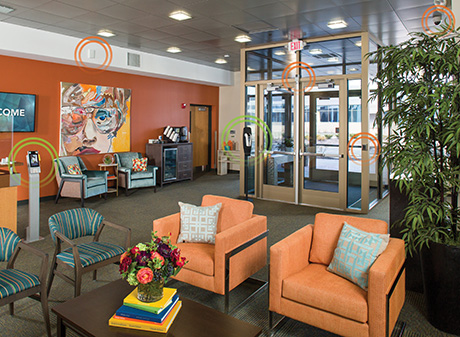COVID-19 made clear the need to overhaul technology capabilities in senior living facilities everywhere. The next wave of senior care’s tech evolution will encompass what the pandemic highlighted: a need for technologies that not only enhance residents’ physical safety, but their holistic wellbeing as well. The pandemic also brought to light a renewed focus on the importance of integrated technologies that improve staff efficiencies. As we explore the next generation of senior living’s technology evolution, it’s important to remember the foundation to all technology advancements: reliable Wi-Fi. The ability to call friends and loved ones, to speak to doctors and facility staff via reliable Internet connection can no longer be an afterthought.

Calie Blanke,
Direct Supply
Calie Blanke works as a marketing manager for Direct Supply, a company focused on providing innovative systems, products and services in the seniors housing field. She notes an expanding interest in solving senior living community challenges via data-driven, high-tech approaches to familiar problems. “We have heard from a number of our customers that they are facing challenges with wireless connectivity, telemedicine, workforce retention, indoor air quality, dignified monitoring and more. As state and local governments aim to make investments in our healthcare systems post-COVID, addressing these challenges will be imperative to ensure a robust long-term care infrastructure capable of meeting the demands of 21st century healthcare.”
New Technology Complicates Wi-Fi Requirements

Christian Buesing,
Direct Supply
Wi-Fi has become the symbol of a once-underutilized technology that became a selling point during the pandemic — and it’s unlikely the importance of Wi-Fi will ever be overlooked again. As we discuss other emerging technologies, it’s important to note that Wi-Fi can easily become the limiting factor, especially where video is needed and where bandwidth and signal strength can be more easily overburdened, explains Christian Buesing, director, Operations – Technology Solutions at Direct Supply.
That can sound complicated, but Buesing explains that if you build the system and design the Wi-Fi correctly from the beginning, these technological counterparts can account for high traffic or connection load and balance themselves, without the need for staff or specialist involvement, saving your team time and money.
“Having a properly designed Wi-Fi system is critically important to getting any of these technologies to communicate and connect reliably.” The number of devices connected to an access point can determine the quality of a Wi-Fi connection, and more devices than ever before are entering these senior living spaces. To support resident communication, it’s best to consider where more access points might be needed. For example, Buesing explains, dining spaces might need additional coverage to cope with competing resident and staff devices as well as Wi-Fi-enabled community technology.
“Considering how the system is going to be used and designing appropriately from the beginning is essential. To make the best use of these systems, communities must understand what problem they need to solve and what need they want to meet. Then, the important thing becomes tailoring the technology solution to meet those needs,” says Buesing.
Beyond Fall Prevention: Addressing a Critical Issue in Senior Care Using Technology and Data
Once your Wi-Fi is in a good place, you can start strategizing what solutions may be a good fit for your community to solve challenges affecting your residents and staff. One common challenge in senior care is preventing falls. Amid the pandemic for example, falls in Memory Care communities increased by a staggering 20%.1 Blanke explains these falls can be both upsetting and dangerous, but, importantly, new technology is making them avoidable and getting residents help faster. SafelyYou, a real time, AI-enabled technology system detects falls for consented individuals living with dementia and has shown up to a 40 percent reduction in falls and up to an 80 percent reduction in emergency room visits. SafelyYou can also provide strong financial outcomes. In a recent study, SafelyYou doubled a community’s length of stay for long-term memory care residents. This can result in an additional $100,000 in revenue in just six months (where communities charged $7,000 per month for a 30-bed memory care unit), for example.
Direct Supply’s partner SafelyYou isn’t just focused on alerting staff when falls occur though: helping establish fall patterns is part of its raison d’etre. Recording fall times and conditions helps staff better anticipate factors that cause falls to create unique, person-centered interventions and individualized strategies going forward. SafelyYou was vetted through Direct Supply’s Innovation & Technology Center (more on them later), using the center’s in-depth research and testing.
Community Insights with Real-Time Location Systems (RTLS)
Another approach to creating a safer, more efficient and well-connected community is real-time location systems (RTLS), which are gaining popularity as staff and resources in senior living communities are stretched thin. Often designed as wearables, these devices indicate where residents and staff are or where they have travelled, meaning that these systems are ideal for contact tracing, tracking resident and staff interactions and locating equipment saving time and money.
CenTrak and Direct Supply have partnered for one such RTLS, specifically designed for senior living communities: TruView. “CenTrak’s TruView allows communities to combine multiple systems, like emergency call and wander management, into one efficient and cost-effective platform. It gives you full visibility into your communities: residents, staff and visitors, as well as your assets,” explains Blanke.

James Jansen,
Direct Supply
James Jansen, product manager, Tech & Electronics, Direct Supply, says “Over the next year or two we’re going to see a lot of new innovation in the resident monitoring space. COVID really highlighted the fact that resident monitoring providers need to up their game, bringing new and differentiated tech. Integrations amongst systems are also valuable. As you invest in a platform, you ask, ‘How can I tie more technology into a platform to make it more impactful to the operation? How can I make my staff more efficient and get more data points to make better decisions?’ These are important considerations when you have fewer staff. You want to make better decisions but not to burden staff with data collection. This technology can do it for you.”
Infection Prevention
A tech-focused approach to indoor air quality control via needlepoint bipolar ionization or UV light has captured the imagination of senior living technology professionals. The industry is grappling with the idea of cleaning and providing high-quality air in both individual and common spaces, says Jansen. “With needlepoint bipolar ionization you’re able to get clean, high-quality air flowing throughout buildings. Air quality became a top concern during COVID, and that’s not going to change. We’ve seen a lot of investment in this type of technology.”
“Caring for air quality metrics of a community (including resident rooms and common spaces) is vitally important to creating safer living environments, which goes hand-in-hand with increasing census,” notes Jansen. “UV-C additions to your HVAC system, which can directly attack pathogens, is another big trend we have seen as an additional technology being deployed to reduce the spread of infectious diseases. We are glad to see some of these advanced technologies make their way into Senior Living, and at a more reasonable price point so more operators can take advantage of them.”
Senior Tech in the Future
Blanke points to Direct Supply’s Innovation & Technology Center as an incubator for future technology. Exploring and fine-tuning senior health, the center partners with startups, universities and senior living communities to envision what’s next in an industry that’s quickly learning the benefits of incorporating tech, even as it strengthens the essentials, like Wi-Fi. Blanke believes the systems that facilities are investing in right now will have applications for old concerns (like cold and flu season) and new concerns (like a potential future pandemic and residents’ emotional and mental well-being). Whatever the future holds, ensuring the right technology foundations are in place will help protect communities, their residents, and staff.
— By Sarah Daniels. This sponsored content was written in conjunction with Direct Supply.
1 SafelyYou data analysis of ~400 fall videos of detection over 8 weeks of fall data across 23 senior living communities prior to and during COVID-19 shelter-in-place initiatives.

